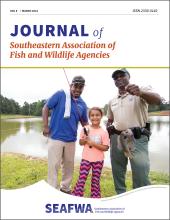How Decision Makers View Wildlife Conservation Challenges in the Southeast United States
Effective wildlife management requires understanding conservation challenges as defined by stakeholders and developing strategic responses to them. Outlining these challenges is the first step in wildlife management decision making. Research has documented how wildlife conservation practitioners and the public prioritize conservation issues, but little is known about the perspectives of people making conservation decisions, exposing a critical blind spot in efforts to effectively manage wildlife. In this case study, we interviewed 19 directors and 29 board members of state wildlife...
